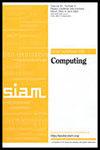Rapid Mixing of Glauber Dynamics up to Uniqueness via Contraction
IF 1.6
3区 计算机科学
Q3 COMPUTER SCIENCE, THEORY & METHODS
引用次数: 1
Abstract
For general antiferromagnetic 2-spin systems, including the hardcore model on weighted independent sets and the antiferromagnetic Ising model, there is an for the partition function on graphs of maximum degree when the infinite regular tree lies in the uniqueness region by Li, Lu, and Yin [Correlation Decay up to Uniqueness in Spin Systems, preprint, https://arxiv.org/abs/1111.7064, 2021]. Moreover, in the tree nonuniqueness region, Sly in [Computational transition at the uniqueness threshold, in Proceedings of the 51st Annual IEEE Symposium on Foundations of Computer Science, 2010, pp. 287–296] showed that there is no to estimate the partition function unless . The algorithmic results follow from the correlation decay approach due to Weitz [Counting independent sets up to the tree threshold, in Proceedings of the 38th Annual ACM Symposium on Theory of Computing, 2006, pp. 140–149] or the polynomial interpolation approach developed by Barvinok [Combinatorics and Complexity of Partition Functions, Springer, 2016]. However, the running time is only polynomial for constant . For the hardcore model, recent work of Anari, Liu, and Oveis Gharan [Spectral independence in high-dimensional expanders and applications to the hardcore model, in Proceedings of the 61st Annual IEEE Symposium on Foundations of Computer Science, 2020, pp. 1319–1330] establishes rapid mixing of the simple single-site Markov chain, known as the Glauber dynamics, in the tree uniqueness region. Our work simplifies their analysis of the Glauber dynamics by considering the total pairwise influence of a fixed vertex on other vertices, as opposed to the total influence of other vertices on , thereby extending their work to all 2-spin models and improving the mixing time. More important, our proof ties together the three disparate algorithmic approaches: we show that contraction of the so-called tree recursions with a suitable potential function, which is the primary technique for establishing efficiency of Weitz’s correlation decay approach and Barvinok’s polynomial interpolation approach, also establishes rapid mixing of the Glauber dynamics. We emphasize that this connection holds for all 2-spin models (both antiferromagnetic and ferromagnetic), and existing proofs for the correlation decay and polynomial interpolation approaches immediately imply rapid mixing of the Glauber dynamics. Our proof utilizes the fact that the graph partition function is a divisor of the partition function for Weitz’s self-avoiding walk tree. This fact leads to new tools for the analysis of the influence of vertices and may be of independent interest for the study of complex zeros.格劳伯动态的快速混合通过收缩达到唯一性
对于一般的反铁磁2-自旋系统,包括加权独立集上的核核模型和反铁磁Ising模型,当无限规则树位于Li、Lu和Yin的唯一性区域时,最大度图上的配分函数存在一个[自旋系统中的相关衰减到唯一性,预印本,https://arxiv.org/abs/1111.7064, 2021]。此外,在树非唯一性区域,Sly在[在唯一性阈值处的计算过渡,在第51届IEEE计算机科学基础研讨会论文集,2010,pp. 287-296]中表明,除非。算法结果来自Weitz的相关衰减方法[计算独立设置到树阈值,在第38届ACM计算理论研讨会论文集,2006,pp. 140-149]或Barvinok开发的多项式插值方法[配分函数的组合学和复杂性,Springer, 2016]。然而,对于常数,运行时间只是一个多项式。对于核心模型,Anari、Liu和Oveis Gharan最近的工作[高维扩展器中的光谱独立性和核心模型的应用,发表于第61届IEEE计算机科学基础研讨会,2020年,第1319-1330页]在树唯一性区域建立了简单单点马尔可夫链的快速混合,称为Glauber动力学。我们的工作简化了他们对格劳伯动力学的分析,考虑了固定顶点对其他顶点的总成对影响,而不是其他顶点对的总影响,从而将他们的工作扩展到所有的2自旋模型,并缩短了混合时间。更重要的是,我们的证明将三种不同的算法方法联系在一起:我们表明,用合适的势函数收缩所谓的树递归,这是建立Weitz的相关衰减方法和Barvinok的多项式插值方法效率的主要技术,也建立了快速混合的Glauber动力学。我们强调,这种联系适用于所有的2-自旋模型(反铁磁和铁磁),并且现有的相关衰减和多项式插值方法的证明立即暗示了Glauber动力学的快速混合。我们的证明利用了图配分函数是Weitz自回避行走树配分函数的除数这一事实。这一事实导致了分析顶点影响的新工具,并可能对复零的研究产生独立的兴趣。
本文章由计算机程序翻译,如有差异,请以英文原文为准。
求助全文
约1分钟内获得全文
求助全文
来源期刊

SIAM Journal on Computing
工程技术-计算机:理论方法
CiteScore
4.60
自引率
0.00%
发文量
68
审稿时长
6-12 weeks
期刊介绍:
The SIAM Journal on Computing aims to provide coverage of the most significant work going on in the mathematical and formal aspects of computer science and nonnumerical computing. Submissions must be clearly written and make a significant technical contribution. Topics include but are not limited to analysis and design of algorithms, algorithmic game theory, data structures, computational complexity, computational algebra, computational aspects of combinatorics and graph theory, computational biology, computational geometry, computational robotics, the mathematical aspects of programming languages, artificial intelligence, computational learning, databases, information retrieval, cryptography, networks, distributed computing, parallel algorithms, and computer architecture.
 求助内容:
求助内容: 应助结果提醒方式:
应助结果提醒方式:


